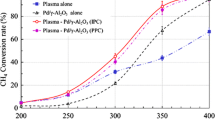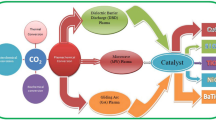Abstract
A non-thermal continuous flow plasma reactor with a liquid water stream and argon carrier gas is shown to convert n-hexane and water into alcohols, alkenes, ketones, hydroperoxides, alpha-hydroxy-ketones and diketones. Fragmented (short chain) primary alcohols, fragmented aldehydes and fragmented carboxylic acids are also formed. The variation of the supply voltage and oxygen concentration allows moderate fine-tuning of yield and selectivity of this organic “diversity-oriented” synthetic process. A (pH based) procedure for rapid separation of the organic hydroperoxides has been developed. Computationally determined thermodynamic and kinetic parameters of several reaction pathways support their feasibility. The construction of a mechanistic pathway map was accomplished, providing deeper insight into this radical and plasma based transformation process.
Graphical Abstract
































Similar content being viewed by others
References
Fridman A (2008) Plasma chemistry. Cambridge University Press, Cambridge
Suhr H (1971) Organic reactions in the plasma of glow discharges. Angew Chem Int Ed Engl 10(6):422. doi:10.1002/anie.197104221
Wertheimer MR (2014) Plasma processing and polymers: a personal perspective. Plasma Chem Plasma Process 34(3):363–376. doi:10.1007/s11090-013-9491-3
Kogelschatz U (1988) Advanced ozone generation. In: Stucki S (ed) Process technologies for water treatment. Plenum Press, New York, pp 87–120
Du C, Mo J, Li H (2014) Renewable hydrogen production by alcohols reforming using plasma and plasma-catalytic technologies: challenges and opportunities. Chem Rev. doi:10.1021/cr5003744
Malik MA, Hughes D, Malik A, Xiao S, Schoenbach KH (2013) Study of the production of hydrogen and light hydrocarbons by spark discharges in diesel, kerosene, gasoline, and methane. Plasma Chem Plasma Process 33(1):271–279. doi:10.1007/s11090-012-9429-1
Burlica R, Shih KY, Hnatiuc B, Locke BR (2011) Hydrogen generation by pulsed gliding arc discharge plasma with sprays of alcohol solutions. Ind Eng Chem Res 50(15):9466–9470. doi:10.1021/ie101920n
Gallagher MJ, Geiger R, Polevich A, Rabinovich A, Gutsol A, Fridman A (2010) On-board plasma-assisted conversion of heavy hydrocarbons into synthesis gas. Fuel 89(6):1187–1192. doi:10.1016/j.fuel.2009.11.039
Holladay JD, Hu J, King DL, Wang Y (2009) An overview of hydrogen production technologies. Catal Today 139(4):244–260. doi:10.1016/j.cattod.2008.08.039
Kim SC, Chun YN (2008) Production of hydrogen by partial oxidation with thermal plasma. Renew Energy 33(7):1564–1569. doi:10.1016/j.renene.2007.09.013
Petitpas G, Rollier JD, Darmon A, Gonzalez-Aguilar J, Metkemeijer R, Fulcheri L (2007) A comparative study of non-thermal plasma assisted reforming technologies. Int J Hydrogen Energy 32(14):2848–2867. doi:10.1016/j.ijhydene.2007.03.026
Sarmiento B, Brey JJ, Viera IG, Gonzalez-Elipe AR, Cotrino J, Rico VJ (2007) Hydrogen production by reforming of hydrocarbons and alcohols in a dielectric barrier discharge. J Power Sources 169(1):140–143. doi:10.1016/j.jpowsour.2007.01.059
Zhu X, Trung H, Lobban LL, Mallinson RG (2014) Partial oxidation of ethanol using a non-equilibrium plasma. Int J Hydrogen Energy 39(17):9047–9056. doi:10.1016/j.ijhydene.2014.03.198
Wandell RJ, Bresch S, Hsieh K, Alabugin IV, Locke BR (2014) Formation of alcohols and carbonyl compounds from hexane and cyclohexane with water in a liquid film plasma reactor. IEEE Trans Plasma Sci 42(5):1195–1205. doi:10.1109/tps.2014.2304183
Kudryashov SV, Perevezentsev SA, Ryabov AY, Shchegoleva GS, Sirotkin EE (2012) Study of the products of benzene transformation in the presence of argon, hydrogen, and propane–butane mixture in barrier discharge. Pet Chem 52(1):60–64. doi:10.1134/s0965544112010057
Kudryashov SV, Ochered’ko AN, Shchegoleva GS, Ryabov AY (2011) Oxidation of propylene with air in barrier discharge in the presence of octane. Russ J Appl Chem 84(8):1404–1407. doi:10.1134/s1070427211080180
Perevezentsev SA, Kudryashov SV, Boganov SE, Ryabov AY, Shchegoleva GS (2011) Transformations of benzene–argon mixture in barrier discharge. High Energy Chem 45(1):62–65. doi:10.1134/s0018143911010127
Kudryashov SV, Ryabov AY, Shchegoleva GS, Savinykh VY, Suslov AI (2008) Oxidative conversion of cyclohexane in discharge plasma maintained with different high-voltage power sources. High Energy Chem 42(1):51–55. doi:10.1134/s0018143908010104
Kudryashov SV, Ryabov AY, Shchegoleva GS, Sirotkina EE, Velichkina LM (2004) Oxidation of hydrocarbons in a bubble plasma reactor. Pet Chem 44(6):438–440
Kudryashov SV, Ryabov AY, Sirotkina EE, Shchegoleva GS (2004) Oxidation of propylene and isobutylene in a reactor with barrier discharge. Russ J Appl Chem 77(11):1904–1906. doi:10.1007/s11167-005-0188-0
Kudryashov SV, Ryabov AY, Sirotkina EE, Shchegoleva GS (2003) Oxidation of cyclohexene in the presence of alkanes in a barrier discharge plasma. High Energy Chem 37(3):184–186. doi:10.1023/a:1024103420667
Kudryashov SV, Shchegoleva GS, Ryabov AY, Sirotkina EE (2002) Simulation of the kinetics of cyclohexane oxidation in a barrier discharge reactor. High Energy Chem 36(5):349–353. doi:10.1023/a:1020254818916
Kudryashov SV, Ryabov AY, Sirotkina EE, Shchegoleva GS (2001) Transformations of n-hexane and cyclohexane by barrier discharge processing in inert gases. High Energy Chem 35(2):120–122. doi:10.1023/a:1004125607204
Kudryashov SV, Shchegoleva GS, Sirotkina EE, Ryabov AY (2000) Oxidation of hydrocarbons in a barrier discharge reactor. High Energy Chem 34(2):112–115. doi:10.1007/bf02761839
Locke BR, Lukes P, Brisset JL (2012) Elementary chemical and physical phenomena in electrical discharge plasma in gas–liquid environments and in liquids. In: Parvulescu VI, Magureanu M, Lukes P (eds) Plasma chemistry and catalysis in gases and liquids. Wiley-VCH Verlag GmbH & Co. KGaA, Weinheim
Lukes P, Locke BR, Brisset JL (2012) Aqueous-phase chemistry of electrical discharge plasma in water and in gas-liquid environments. In: Parvulescu VI, Magureanu M, Lukes P (eds) Plasma chemistry and catalysis in gases and liquids. Wiley-VCH Verlag GmbH & Co. KGaA, Weinheim
Locke BR, Shih KY (2011) Review of the methods to form hydrogen peroxide in electrical discharge plasma with liquid water. Plasma Sources Sci Technol 20(3):15. doi:10.1088/0963-0252/20/3/034006
Hoeben W, Boekhoven W, Beckers F, van Heesch EJM, Pemen AJM (2014) Partial oxidation of methane by pulsed corona discharges. J Phys D-Appl Phys 47(35):10. doi:10.1088/0022-3727/47/35/355202
Wandell RJ, Locke BR (2014) Low-power pulsed plasma discharge in a water film reactor. IEEE Trans Plasma Sci 42(10):2634–2635. doi:10.1109/tps.2014.2310055
Eisenberg GM (1943) Colorimetric determination of hydrogen peroxide. Ind Eng Chem-Anal Ed 15:327–328. doi:10.1021/i560117a011
Alabugin IV, Manoharan M, Breiner B, Lewis FD (2003) Control of kinetics and thermodynamics of [1,5]-shifts by aromaticity: a view through the prism of Marcus theory. J Am Chem Soc 125(31):9329–9342. doi:10.1021/ja035729x
Alabugin IV, Manoharan M (2005) Thermodynamic and strain effects in competition between 5-exo-dig and 6-endo-dig cyclizations of vinyl and aryl radicals. J Am Chem Soc 127(36):12583–12594. doi:10.1021/ja052677y
Atkinson R (2003) Kinetics of the gas-phase reactions of OH radicals with alkanes and cycloalkanes. Atmos Chem Phys 3:2233–2307
Pati K, dos Passos Gomes G, Harris T, Hughes A, Phan H, Banerjee T, Hanson K, Alabugin IV (2015) Traceless directing groups in radical cascades: from oligoalkynes to fused helicenes without tethered initiators. J Am Chem Soc 137(3):1165–1180. doi:10.1021/ja510563d
Alabugin IV, Bresch S, Gomes GdP (2015) Orbital hybridization: a key electronic factor in control of structure and reactivity. J Phys Org Chem 28(2):147–162. doi:10.1002/poc.3382
Anslyn E, Doughert D (2006) Modern physical organic chemistry. University Science Books, Sausalito
Wang Z, Herbinet O, Cheng Z, Husson B, Fournet R, Qi F, Battin-Leclerc F (2014) Experimental investigation of the low temperature oxidation of the five isomers of hexane. J Phys Chem A 118(30):5573–5594. doi:10.1021/jp503772h
Mondal S, Gold B, Mohamed RK, Alabugin IV (2014) Design of leaving groups in radical C–C fragmentations: through-bond 2c–3e interactions in self-terminating radical cascades. Chem Eur J 20(28):8664–8669. doi:10.1002/chem.201402843
Mondal S, Gold B, Mohamed RK, Phan H, Alabugin IV (2014) Rerouting radical cascades: intercepting the homoallyl ring expansion in enyne cyclizations via C–S scission. J Org Chem 79(16):7491–7501. doi:10.1021/jo5012043
Mohamed RK, Mondal S, Gold B, Evoniuk CJ, Banerjee T, Hanson K, Alabugin IV (2015) Alkenes as alkyne equivalents in radical cascades terminated by fragmentations: overcoming stereoelectronic restrictions on ring expansions for the preparation of expanded polyaromatics. J Am Chem Soc 137(19):6335–6349. doi:10.1021/jacs.5b02373
Dolan TJ (1993) Electron and ion collisions with water-vapor. J Phys D-Appl Phys 26(1):4–8
Liu DX, Bruggeman P, Iza F, Rong MZ, Kong MG (2010) Global model of low-temperature atmospheric-pressure He + H2O plasmas. Plasma Sources Sci Technol 19(2):025018. doi:10.1088/0963-0252/19/2/025018
Atkinson R (1989) Kinetics and mechanisms of the gas-phase reactions of the hydroxyl radical with organic compounds. Journal of physical and chemical reference data, Monograph No. 1. American Chemical Society, Washington; American Institute of Physics, for the National Institute of Standards and Technology, New York
Mevel R, Chatelain K, Boettcher PA, Dayma G, Shepherd JE (2014) Low temperature oxidation of n-hexane in a flow reactor. Fuel 126:282–293. doi:10.1016/j.fuel.2014.02.072
Jungkamp TPW, Smith JN, Seinfeld JH (1997) Atmospheric oxidation mechanism of n-butane: the fate of alkoxy radicals. J Phys Chem A 101(24):4392–4401. doi:10.1021/jp970212r
Grymonpre D, Finney W, Clark R, Locke B (2004) Hybrid gas–liquid electrical discharge reactors for organic compound degradation. Ind Eng Chem Res 43(9):1975–1989
Gilmore K, Kopetzki D, Lee JW, Horváth Z, McQuade DT, Seidel-Morgenstern A, Seeberger PH (2014) Continuous synthesis of artemisinin-derived medicines. Chem Commun 50:12652–12655. doi:10.1039/C4CC05098C
Acknowledgments
We would like to acknowledge the financial support from the National Science Foundation (CBET 1236225).
Author information
Authors and Affiliations
Corresponding authors
Electronic supplementary material
Below is the link to the electronic supplementary material.
Rights and permissions
About this article
Cite this article
Bresch, S., Wandell, R., Wang, H. et al. Oxidized Derivatives of n-Hexane from a Water/Argon Continuous Flow Electrical Discharge Plasma Reactor. Plasma Chem Plasma Process 36, 553–584 (2016). https://doi.org/10.1007/s11090-015-9686-x
Received:
Accepted:
Published:
Issue Date:
DOI: https://doi.org/10.1007/s11090-015-9686-x




